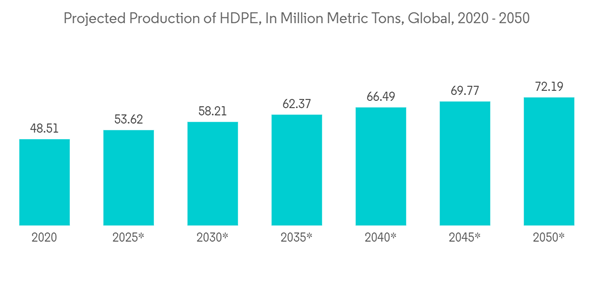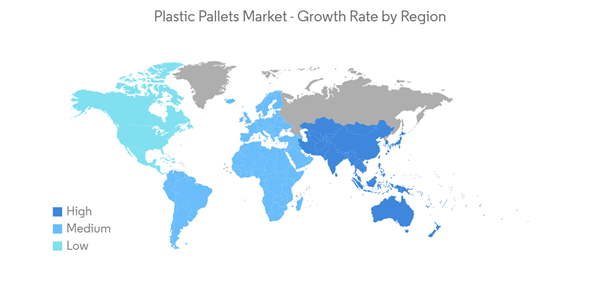Plastic pallets are rigid forms that provide mechanical stability to bulk goods during handling to preserve quality. Handling comprises all activities related to lifting, stacking, product storage, and transportation by land or sea. Plastic pallets are developed to be moveable by equipment such as forklifts, pallet jacks, and front loaders to facilitate the mobility of goods.
Key Highlights
- Plastic pallets are made of HDPE, polypropylene, etc. HDPE, or high-density polyethylene, is the most common resin in plastic pallets. This material has all the properties most standard applications demand: durability, stiffness, and moisture resistance. HDPE is ideal for the demanding and repeated use found in warehouses.
- The increasing popularity of e-commerce resulted in the expansion of logistics activities and, in turn, surged the demand for pallets worldwide. Furthermore, increasing penetration of organized retail is anticipated to drive the demand for pallets as these are widely used in retail spaces for the loading and unloading of heavy merchandise.
- According to Tosca Services LLC, home construction, manufacturers, and supply chain operators faced challenges as costs rose to USD 1500 per 1000 feet a couple of years back, nearly doubling in prices. This volatility has directly impacted the use of wooden pallets. These wood pallets, central to supply chain optimization for years, have become a significant expense. However, to stabilize pricing and avoid unanticipated costs, companies have found a long-term smart packaging solution in reusable plastic pallets in 2020. The benefits of reusable plastic pallets go beyond price and will influence the future of global shipping in everything from environmental regulation to supply chain traceability.
- However, several factors, such as the high cost of plastic pallet and their sustainability issues, limit their widespread penetration. A plastic pallet is made in the one-piece molding process, so it cannot be repaired once damaged. Since the plastic pallet is not as rough as the wooden pallet and its surface is smooth, it causes the goods to face signs of sliding on it, damaging the products.
- The impact of COVID-19 and the Russia-Ukraine conflict had significant long-term effects on the market studied. The impact brought changes in consumer behavior, supply chain disruptions, and government interventions caused by the pandemic. The impact of the Russia-Ukraine conflict has been witnessed across various regions. Major sectors affected were the supply chain bottlenecks and energy prices that caused problems for raw material suppliers. Russia and Ukraine are significant suppliers and producers of several raw materials. The conflict also added uncertainty to business investment and volatility to financial markets.
Plastic Pallets Market Trends
High-Density Polyethylene (HDPE) to Hold Major Market Share
- Polyethylene (PE) is one of the most durable types of plastic currently available. It is resistant to chemicals and has a low cost. PE has been derived from petroleum polymers and can withstand any environmental hazard. High-density polyethylene (HDPE) is one of the most common types of plastic used for rigid packaging, especially in manufacturing. HDPE is known for its strength and durability. This type of plastic might also be color-matched and is popular in white. HDPE is frequently used in the production of plastic pallets.
- HDPE pallets are the most used plastic pallets due to their versatility, cost-effectiveness, and strength. They have high impact strength, absorb shock, and maintain stability even if accidentally dropped or subjected to a significant force during transportation or storage. HDPE pallets are corrosion and heat-resistant and compatible with most chemicals. However, its preferred applications are expected to avoid extensive contact with oxidizing agents and hydrocarbons. This type of plastic is also popular and similar to PP, but HDPE is stiffer and stiffer. In addition, it can withstand higher temperatures than PP. These pallets are used when larger weights need to be held or when sanitary regulations exist.
- Major HDPE pallet vendors concentrate on producing green plastic pallets using 100% recyclable plastic polymers. Regarding manufacturing methods, most vendors use injection molding to produce HDPE plastic pallets. The industrial goods and automotive industries are common in which HDPE is used. As a result, HDPE is the leading plastic pallet in the world and is expected to remain the leader in the coming years. Nested plastic HDPE pallets are designed to save space and reduce transportation costs. The unique design allows them to be nested inside each other when empty, allowing load significantly more in the truck on the way home than traditional wooden pallets. There is a rising demand for HDPE pallets across the end-user segments.
- The use of plastic pallets in the food and beverage industry eliminates many of the risks associated with wood pallets and associated food contamination. The plastic pallets are easier to clean and sanitize than the wood pallets. The plastic material does not absorb water, so any surface contamination is readily destroyed during cleaning. HDPE disposable plastic pallets are extensively used in the food and beverage industry as they are highly resistant to organic and inorganic chemicals at normal temperatures.
- As per the article published by the Nelson Company in March 2023, HDPE is the most widely used plastic pallet resin. HDPE has all the characteristics that most standard applications require, including durability, rigidity, and resistance to moisture. It is suitable for the heavy and repetitive applications found in warehouses. According to the International Energy Agency, a Paris-based autonomous intergovernmental organization, the global production capacity of HDPE is expected to shoot up from 48.51 million metric tons in 2020 to 72.19 million metric tons in 2050. With the rising capacity of HDPE during the forecast period, the market for HDPE pallets is also expected to gain a percentage contribution.
Asia-Pacific Expected to Witness Significant Growth
- Plastic pallets are highly resistant to insects and fungi. It is lightweight, cost-effective, and offers high quality, so it can be used for a long time. It also offers high and dependable performance and is safe for the environment. It is easy to pull on and off in the four-way stretch forklift. The correct size and compact design allow it to be placed everywhere to free up space in tight places. Plastic pallets are attractive for their recyclable qualities, but this is not a high priority in China and India.
- China's export performance has consistently increased over the past ten years, except in 2016, when global demand decreased again after the crisis in 2009
- In addition to being one of the world's most populated nations, China has established itself as the world's largest producer and exporter, according to the World Trade Organization (WTO).
- In India, the growing demand for seafood and electronics is expected to support the growth of plastic pallets as they do not absorb moisture. They are prone to common issues with wood pallets, such as infestation, rot, odor absorption and fumigation, and elimination of static electricity in a controlled manner, along with the convenience of quick and thorough cleaning or washing between uses.
- In Japan, the use of plastic pallet displays is a common practice in retail. These displays are utilized to facilitate the transportation of goods with reduced risk of damage during transport. The only items that need to be handled are the pallets, not the contents. Therefore, the shelving option is ideal for retail stores that offer delicate products.
- The retail industry is one of the most significant contributors to any economy and one of the biggest consumers of logistics solutions, transporting various consumer goods throughout the supply chain. Logistics has become more professionalized in recent years and is now one of the key distinguishing factors among the multiple players in the sector. Retail is one of the most demanding sectors in terms of logistics operation efficiency, where plastic logistic solutions such as pallets, crates, and containers play a crucial role. These factors reinforce two expected benefits in the logistics operations of the retail industry: sustainability and improving reverse logistics.
Plastic Pallets Industry Overview
The plastic pallets market is fragmented. Major players in the market include Cabka Group GmbH, Q-Pall BV, ORBIS GmbH, Schoeller Allibert Group BV, and more. These companies focus on expanding their business through collaborations, investments, etc.For instance, in July 2023, Geoplatics.com and Q-Pall launched heavy-duty pallets in the United Kingdom. This heavy-duty, open-deck plastic pallet manufactured by Netherlands-based Q-Pall has been mainly designed to handle large amounts of materials and ingredients for manufacturers and other industries, including those transporting and storing chemical drums and bulk bags. The pallet, which measures 1200 mm x 1200 mm x 165 mm, is an enhanced version of the original Q-pall 1212 HR 6R. With a static load of 7,500 kg and a dynamic load of 2,000 kg, it is a highly reliable option for heavy-duty applications.
In April 2023, ORBIS Corporation, a global player in reusable packaging, announced that its 40 by 48-inch reusable pallet, the P3, completed 280 cycles in the FastTrack lifecycle analysis. This equates to more than 25 times the lifecycle of a typical 40-by-48-inch white wood stringer pallet. The P3 is a high-density, lightweight, stackable, hygienic reusable packaging solution that seamlessly integrates with both manual and automated material handling equipment.
Additional Benefits:
- The market estimate (ME) sheet in Excel format
- 3 months of analyst support
This product will be delivered within 2 business days.
Table of Contents
Companies Mentioned (Partial List)
A selection of companies mentioned in this report includes, but is not limited to:
- WERIT Kunststoffwerke W. Schneider GmbH & Co. KG
- Gamma-Wopla NV and Smart-Flow NV
- Q-Pall BV
- CABKA Group Gmbh
- Schoeller Allibert Group BV
- Omnipack s.r.o.
- Orbis Corporation
- NAECO SL
- Plasgad Plastic Products ACS Ltd
- CHEP (Commonwealth Handling Equipment Pool)










